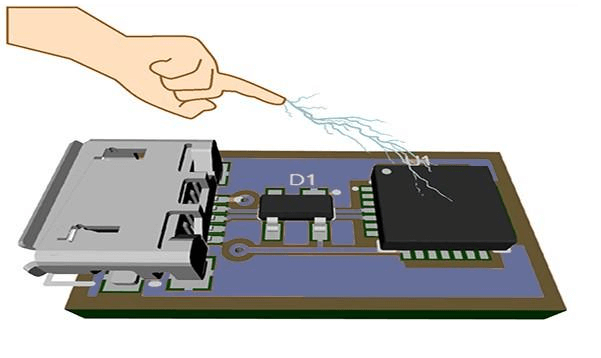ESD protection refers to the measures and techniques used to safeguard sensitive electronic components and devices from damage caused by electrostatic discharge (ESD). ESD occurs when there is a sudden transfer of electrostatic charge between two objects at different electrical potentials, often resulting in a visible spark. This phenomenon can cause immediate or latent damage to electronic components, leading to malfunctions, reduced lifespan, and increased maintenance costs.
Electrostatic Discharge (ESD) is a significant concern in the design and operation of electronic devices. ESD events can cause damage to sensitive components, leading to malfunctions and reduced lifespan of electronic systems. Capacitors play a crucial role in protecting electronic circuits from ESD events. Here’s why capacitors are used for ESD protection:
1. Shunting High-Frequency Transients
Capacitors act as a first line of defense by shunting high-frequency ESD transients to the ground. This action helps in reducing voltage spikes that can damage sensitive components. By providing a low-impedance path to the ground, capacitors effectively divert the ESD energy away from the critical parts of the circuit.
2. Absorbing Charge
During an ESD event, a significant amount of charge is injected into the circuit. Capacitors are designed to absorb this charge, thereby preventing the voltage from rising to dangerous levels. This absorption capability is essential in maintaining the integrity of the circuit and protecting it from potential damage.
3. Fast Response Time
ESD events are characterized by their high speed and short duration. Capacitors, especially those designed for ESD protection, have a very fast response time, often less than 1 nanosecond. This rapid response ensures that the ESD energy is quickly dissipated, minimizing the risk of damage to the circuit.
4. Low Capacitance and High Impedance
ESD protection capacitors are typically designed with low capacitance and high impedance. This design ensures that they do not significantly affect the normal operation of the circuit. The low capacitance helps maintain the signal integrity, while the high impedance ensures that the capacitors do not load down the signal lines.
5. Compact Size and High Integration
ESD protection capacitors are often available in small sizes, such as 0402 chip packages. This compact size allows for high integration into modern electronic devices, where space is a critical factor. The small size also contributes to the overall efficiency and performance of the circuit.
6. Cost-Effectiveness
While specialized ESD protection capacitors can be more expensive than standard capacitors, they offer significant benefits in terms of reliability and protection. The cost of incorporating these capacitors into a design is often justified by the reduced risk of ESD-related failures and the potential for increased product lifespan.
7. Versatility in Applications
Capacitors are used in a wide range of applications for ESD protection, including signal lines, power lines, and data lines. They are effective in protecting various types of electronic components, from microcontrollers to sensors, ensuring comprehensive protection across different parts of the circuit.
In summary, capacitors are essential for ESD protection due to their ability to shunt high-frequency transients, absorb charge, respond quickly, and maintain low capacitance and high impedance. Their compact size, high integration, and cost-effectiveness make them a reliable choice for protecting sensitive electronic circuits from ESD events. By incorporating capacitors into the design, engineers can enhance the robustness and reliability of electronic devices, ensuring they perform optimally in various environments.

